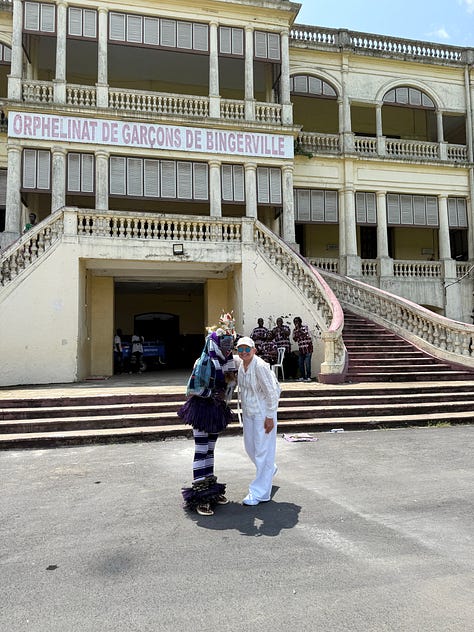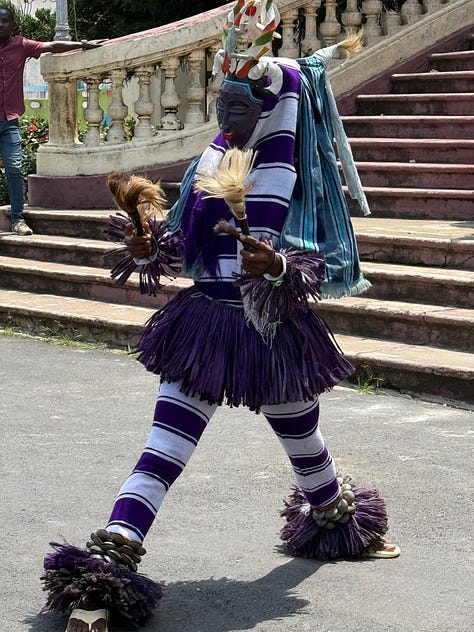Empathy in Two Acts: Language, rhythm, and the ethics of giving in Abidjan
Cartographies of Elsewhere, Dispatch 08, Danuta's Flights
There are spaces that ask for attention not through grandeur, but through their quiet disrepair—through the way they carry history without explanation. An orphanage, Orphelinat De Bingerville, located on the outskirts of Abidjan, Côte d’Ivoire, is one of them. Built in the post-colonial era, the structure is dignified, weathered, and undeniably present. Its broad staircase curves upward toward a second-floor entrance, framed in shadow and softened by time. The paint is peeling. The walls show their seams. But nothing here feels accidental. It feels, instead, like a place that holds memory through structure.
Inside, a long, dark wooden conference table, possibly the longest I’ve ever seen, anchors the room. Around it, white plastic chairs, stackable and stark, their impermanence echoing the transient nature of aid, of intervention, of visitors like us. We are more than a hundred, a traveling cohort seated and standing in awkward proximity. Few of us know exactly why we’ve been brought here. Most are past child-rearing age. There is no clear context. Only the sight of two men at the head of the table, standing beside a white plastic box and a brown paper bag, ordinary objects whose meaning remains suspended.
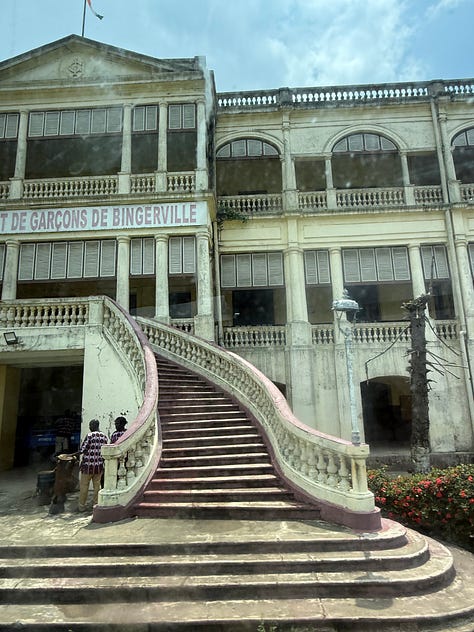
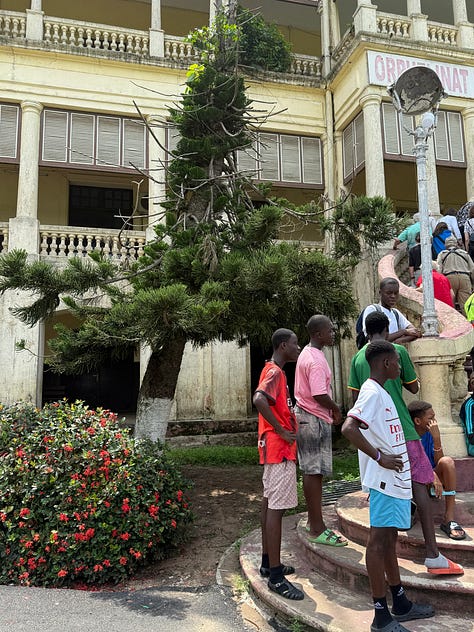
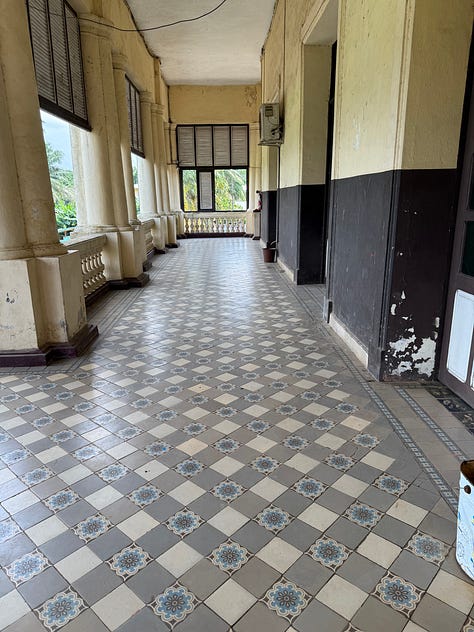
The air is stale, arrested. A fan rotates near the high ceiling, but the temperature does not shift. Even the walls seem to reflect the strain of dichotomy. The lower half freshly painted a pale mint green, the upper half still faded yellow, as if a renovation began but was never completed. On one wall, a photograph of two boys smiling down at the room suggests an intent to humanize what otherwise feels procedural. Two small watercolors, bright, tentative, depict hearts and childlike joy. But the room, like its paint, holds tension between what is intended and what is unfinished.
Eventually, one of the men begins to speak in French. A guide-turned-translator interprets each line slowly. We learn that the orphanage was originally built to house the unclaimed children of French colonial officials, men who fathered children with local women but could not acknowledge them back home. The orphanage, then, began as a repository for denial, a place to contain what empire could not integrate.
Today, it houses about 200 boys. Girls are located at a separate facility. The criteria for admission are specific, a child must be between five and twenty-five, and must have lost both parents or live with a caregiver unable to provide support. At one point, the speaker adds another considered criterion, but the translator falters. A second guide steps in. Then a third. Finally, the word is found: disabled.
The heat is oppressive now. The room pulses with discomfort. The speaker’s remarks are long and unscripted. Listeners fidget, uncrossing and recrossing legs, shifting in plastic chairs, stealing glances at the door. During the untranslated stretches of French, small conversations bloom in the corners. Someone takes a sip of water. Another person quietly takes a photo. The rhythms of engagement are inconsistent—fatigue, attention, empathy, resistance.

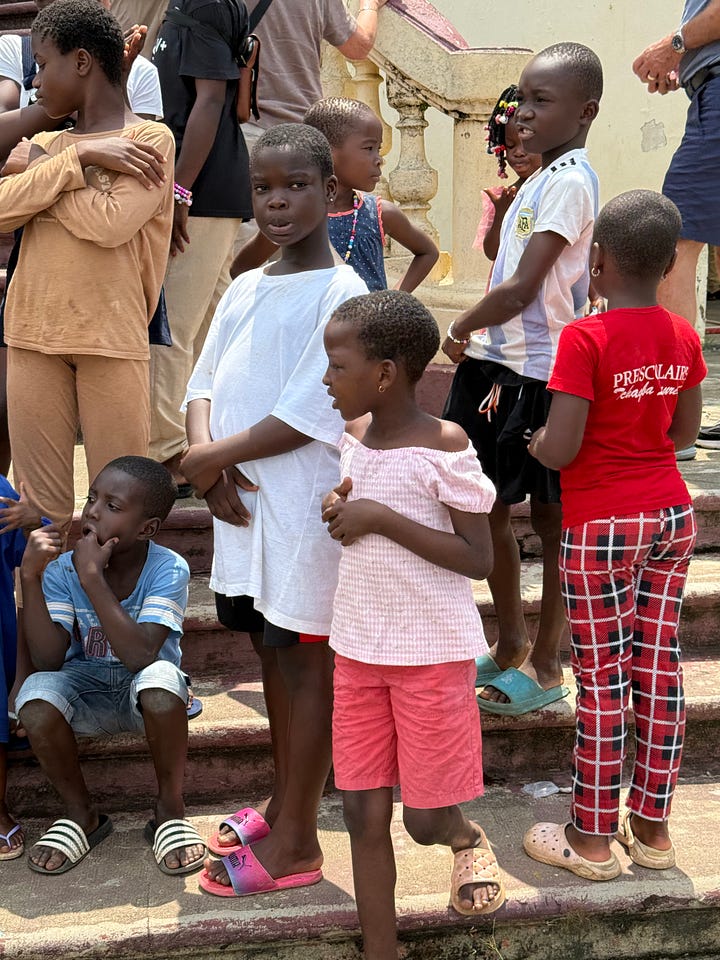
And then, the momentum shifts.
A man near the front asks: “Who funds the orphanage?” The translator responds, “The government.” Another question follows, “Where can we make a donation?” Finally, the mystery of the white box and the paper bag is resolved, they are there to receive our offerings.
A woman near me whispers to her companion, “We’ll never know where the money goes.” Her tone is not cynical, exactly, but protective. A soft skepticism shaped by experience, by distance, by the dissonance between what is asked and what is felt.
Donations trickle in as people begin to rise from their seats. The gesture of giving feels strangely detached, an obligation, more than a response. The translator’s voice, though well-meaning, breaks the emotional current. Meaning becomes transactional. The white box absorbs money, but not feeling. The gesture remains flat, bureaucratic, unresolved.
Then we are told, almost as an afterthought, that a group of children has prepared a welcome dance for us. We are invited to gather downstairs.
And downstairs, something shifts.
A masked dancer appears, his body almost entirely concealed beneath layers of fabric and shell. Only his hands and feet are visible. The mask, feminine and elaborate, sits atop a headpiece that trails behind him. He wears purple and white, his leggings tight and rhythmic, his skirt of straw and shells creating a percussive accompaniment to each step.
This is Zaouli, a traditional dance of the Guro people in central Côte d’Ivoire. Performed by men wearing female masks, Zaouli honors beauty, community, and ancestral spirit. Recognized by UNESCO as intangible cultural heritage, it is not entertainment. It is lineage made visible.
The dancer begins. His feet move impossibly fast while his upper body remains almost still. The motion is trance-like, cyclical, breathtaking. His body carries the rhythm of something ancient, something encoded in muscle and bone. Behind him, boys in matching attire play drums with precision and grace. No words are spoken. No translation is needed. The language here is movement, and we all understand it.
On a square of cloth spread on the ground, anchored by a piece of wood to keep the wind from lifting it, the crowd begins to leave donations—more, this time. Fives. Tens. Twenties. The same people who hesitated upstairs now reach into their pockets, unprompted. The difference is visceral.
Why?
Because the dancer gave us something embodied. There was no intermediary, no translation. His gift arrived unmediated—pulse, rhythm, muscle, motion, breath. It was not a narrative about need. It was communion. It was beauty offered without justification. And in that offering, we were implicated, not as spectators, but as witnesses invited to experience something extraordinary.
We watched him move with a precision that felt ancient, a rhythm so intact it seemed to have survived erasure. And perhaps that was what undid us all. For a moment, we were not simply watching a performance, we were watching what remains when a world is taken apart and something refuses to vanish.
I thought of the languages lost to colonization, of stories cut off mid-sentence, of gestures and rituals deemed backwards, unproductive, unworthy. I thought of how many words have been buried, how many names left unspoken, how many systems of knowing dismantled and replaced.
The dancer did not explain this. He did not need to. His body carried what the archive could not. What he enacted was not recovery, but continuity—quiet, insistent, alive.
And as I watched, I felt something more difficult than admiration. I felt sorrow. Shame. Gratitude.
Sorrow for what has been destroyed, the languages silenced before they could become literature, the gestures forgotten because no one remained to remember them, the cultural universes that once structured entire worlds, now reduced to artifacts in glass cases.
Shame, too—for standing within the long shadow of colonial history, for moving freely through a world that still bears the architecture of inequality, even if I did not build it. It is a shame not of guilt, but of awareness—of recognizing that I benefit from systems that cost others their names, their labor, their futures.
And then, layered beneath and around it all, gratitude. For the rhythm that persisted anyway. For the dance that refused disappearance. For the grace that was not withdrawn, but extended—to me, to all of us, as if we belonged, if only briefly, to the shared beat of a drum and the arc of a motion older than loss.
It was not forgiveness. It was not absolution.
It was something quieter. A gift.
And I accepted it the only way I knew how, by paying attention.

